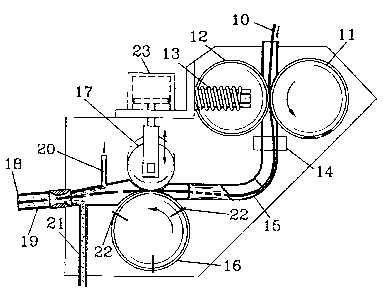Some of the information on this Web page has been provided by external sources. The Government of Canada is not responsible for the accuracy, reliability or currency of the information supplied by external sources. Users wishing to rely upon this information should consult directly with the source of the information. Content provided by external sources is not subject to official languages, privacy and accessibility requirements.
Any discrepancies in the text and image of the Claims and Abstract are due to differing posting times. Text of the Claims and Abstract are posted:
| (12) Patent: | (11) CA 2195399 |
|---|---|
| (54) English Title: | APPARATUS FOR CUTTING REINFORCING FIBRE MATERIAL |
| (54) French Title: | DISPOSITIF SERVANT A COUPER DES FIBRES DE RENFORCEMENT |
| Status: | Term Expired - Post Grant Beyond Limit |
| (51) International Patent Classification (IPC): |
|
|---|---|
| (72) Inventors : |
|
| (73) Owners : |
|
| (71) Applicants : |
|
| (74) Agent: | MARKS & CLERK |
| (74) Associate agent: | |
| (45) Issued: | 2005-05-24 |
| (86) PCT Filing Date: | 1995-07-11 |
| (87) Open to Public Inspection: | 1996-02-01 |
| Examination requested: | 2002-06-14 |
| Availability of licence: | N/A |
| Dedicated to the Public: | N/A |
| (25) Language of filing: | English |
| Patent Cooperation Treaty (PCT): | Yes |
|---|---|
| (86) PCT Filing Number: | PCT/SE1995/000842 |
| (87) International Publication Number: | WO 1996002475 |
| (85) National Entry: | 1997-01-17 |
| (30) Application Priority Data: | ||||||
|---|---|---|---|---|---|---|
|
An apparatus for cutting fibrous reinforcement material
in relationship with an ejector nozzle. The apparatus
comprises at least two feeding rollers and a rotary cutter
which is provided with a substantially cylindric mantle
surface with attachments for a number of knife means. These
cooperate with a support roller with an elastic surface layer
for forming a thread nip. The mantle surface of the cutter
is provided with slot-shaped recesses for the fibre thread
which recesses extend peripherally along the mantle surface
between the knife means. The recesses enable the thread to
be fed forward by means of the feeding rollers at a feeding
rate which deviates from the speed of the cutter, for
adaption of the cutting length of the fibre thread.
Dispositif servant à couper des fibres de renforcement (10) et coopérant avec une buse d'éjection (19). Ce dispositif comprend au moins deux rouleaux d'alimentation (11, 12) et un ensemble coupant rotatif (16) pourvu d'une surface sensiblement cylindrique comportant des points de fixation pour plusieurs lames (22). Ces éléments coopèrent avec un rouleau de support (17) pourvu d'une couche superficielle élastique (17a), afin de constituer un point de contact avec la fibre. La surface de l'ensemble coupant (16) comporte des évidements en forme de fentes (24) dans lesquels passe la fibre (10) et qui s'étendent sur la circonférence de ladite surface, dans le sens de sa longueur, entre les lames (22). Ces évidements permettent de faire avancer la fibre par l'intermédiaire des rouleaux d'alimentation (11, 12) à une cadence différente de la vitesse de l'ensemble coupant (16), afin d'adapter la longueur de coupe de ladite fibre.
Note: Claims are shown in the official language in which they were submitted.
Note: Descriptions are shown in the official language in which they were submitted.

2024-08-01:As part of the Next Generation Patents (NGP) transition, the Canadian Patents Database (CPD) now contains a more detailed Event History, which replicates the Event Log of our new back-office solution.
Please note that "Inactive:" events refers to events no longer in use in our new back-office solution.
For a clearer understanding of the status of the application/patent presented on this page, the site Disclaimer , as well as the definitions for Patent , Event History , Maintenance Fee and Payment History should be consulted.
| Description | Date |
|---|---|
| Inactive: Expired (new Act pat) | 2015-07-11 |
| Inactive: Payment - Insufficient fee | 2012-06-27 |
| Inactive: Office letter | 2007-01-26 |
| Inactive: Corrective payment - s.78.6 Act | 2007-01-18 |
| Inactive: IPC from MCD | 2006-03-12 |
| Inactive: IPC from MCD | 2006-03-12 |
| Inactive: IPC from MCD | 2006-03-12 |
| Grant by Issuance | 2005-05-24 |
| Inactive: Cover page published | 2005-05-23 |
| Pre-grant | 2005-03-15 |
| Inactive: Final fee received | 2005-03-15 |
| Amendment After Allowance (AAA) Received | 2005-02-15 |
| Letter Sent | 2004-09-17 |
| Notice of Allowance is Issued | 2004-09-17 |
| Notice of Allowance is Issued | 2004-09-17 |
| Inactive: Approved for allowance (AFA) | 2004-09-08 |
| Inactive: Application prosecuted on TS as of Log entry date | 2002-07-12 |
| Letter Sent | 2002-07-12 |
| Inactive: Status info is complete as of Log entry date | 2002-07-12 |
| Inactive: Entity size changed | 2002-07-12 |
| All Requirements for Examination Determined Compliant | 2002-06-14 |
| Request for Examination Requirements Determined Compliant | 2002-06-14 |
| Application Published (Open to Public Inspection) | 1996-02-01 |
There is no abandonment history.
The last payment was received on 2004-07-09
Note : If the full payment has not been received on or before the date indicated, a further fee may be required which may be one of the following
Please refer to the CIPO Patent Fees web page to see all current fee amounts.
Note: Records showing the ownership history in alphabetical order.
| Current Owners on Record |
|---|
| APLICATOR SYSTEM AB |
| Past Owners on Record |
|---|
| KJELL SAND |